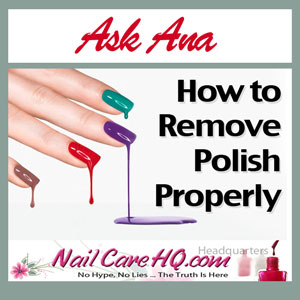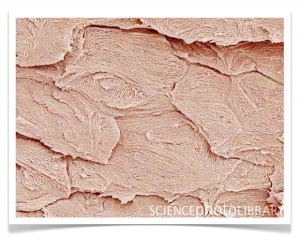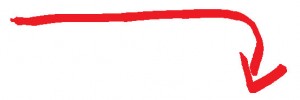 Yellow Nails – How To Remove Nail Polish Properly
Yellow Nails – How To Remove Nail Polish Properly
ASK ANA: Yellow Nails – How To Remove Nail Polish Properly
ASK ANA
Hi Ana! I have a question that’s been bugging me. I have semi-stained nails, they’re not as yellow as the one you’ve posted in your Yellow Nail – Is There a Basecoat that Prevents It? article, but if you place my nail next to someone else’s nails who hasn’t used nail polish, there’s a clear difference that hers are whiter.
One of my friends told me that I should be letting my nails ‘regrow’ so the yellow will go away…? So I should stay away from any nail polish until the nail regrows and it is back to its normal state.
Does this work and is this true? I’m very confused.
I’ve also tried everything to get rid of the remaining stain…. from lemons to whitening toothpaste to whitening cleanser and nothing seems to work! ~Lucy
ANSWER
The short answer is if you love nail polish, you’re going to have stained nails.
Embrace it.
Getting Up Close
Nail Keratin Cells Under Electron Microscope

The long answer is that we need to understand how dyes and pigments work in nail polish.
We also need to to understand how those ingredients affect the nail plate with our removal technique.
Our nail plates are made up of 100 layers of keratin.
The cells are layered like shingles on your roof.
The layers on your nails grow from your cuticle line to your tips.
Polish Pigments
“Pigments are the heart of the polish. They provide the color and covering power. A white pigment called titanium dioxide is frequently combined with colored pigments to increase coverage or produce pastel colors. Other pigments, such as bismuth oxychloride and the mineral mica, are coated with a thin layer of titanium dioxide or other colorants to create many beautiful iridescent shades. Dyes are also occasionally used to modify the color.
What’s the difference between pigments and dyes?
Pigments do not dissolve in the nail polish formulation. They’re finely ground solid particles of color. But even when ground into tiny particles, the pigments are still far too large to penetrate the nail pate plate and cause staining.
Dyes are soluble and dissolve in the formulation. Food coloring see used to color Easter eggs are examples of soluble dies. Notice how easily the dice oaks into the surface of the egg to stain it?” ~Doug Schoon, author of Nail Structure and Product Chemistry
Stop Using Polish? Say It Ain’t So!
Yes, if you never wear polish again, you will have beautiful clean looking nails. In essence your friend is correct.
Her advice is boring.
I, like you, love all the pretty colors, glitters, chromes, holographics, etc. My life would be just too dull without polish.
No Scrub-a-Dubbing Allowed
Most people soak a cotton ball with polish remover and start scrubbing side to side, then back and forth.
Just keep working at it until it’s dissolved. Right?
Wrong.
There’s a Better Way
I learned the best and quickest way to remove polish from Deborah Lippmann. She’s responsible for applying and removing a lot of polish for models on the fashion runways. Her focus is speed.
All Lacquered Up introduced us to Deborah’s easy polish removal method on YouTube.
Deborah completely saturates the cotton with acetone and pulls the cotton apart as you’ll see in the video.
I prefer to unroll a cotton ball and cut it into small pieces. I also use Q-tips to remove base coat and topcoat from the underside of my tips.
Use of pure acetone with complete saturation is very important—and it’s extremely COLD! It feels like you’re soaking in ice because acetone evaporates so fast.
I coat my skin with a cheap kitchen oil before removing my manicure.
It blocks some of that numbing cold and prevents acetone from dissolving your precious body oil and drying out your skin.
It’s tough to see in the video, but Ms. Lippmann is saturating a second cotton with acetone to wipe of the first piece of cotton.
This is an important step as well. It will help you get a firm grip to remove the polish in one, clean swipe.
Knowledge Is Power
Combining this technique with the understanding of the nail plate’s structure, it’s easy to see that this is the best way to remove polish.
By completely dissolving the polish first, and sliding it off in the same direction as the keratin cells grow, it helps reduce yellow stains.
Notice I said reduce?
Depending on the amount of dyes in a polish’s formulation, you just won’t be able to completely stop the yellow stains.
The formulation of the polish determines performance, not the brand name.
I have used several salon quality, more expensive polishes that have stained just as well as the inexpensive drug-store brands.
Steps To Success
Do Not Buff Out Yellow Stains
And for that matter, don’t buff ever.
Since you’ve only got about 50 layers of keratin. Each time you buff, you remove a layer or two.
No big deal?
It takes about 4 months for your nails to completely replace themselves from cuticle line to tip.
If you buff your nails every week, then you’ve shaved down 16 to 36 layers!
Then you wonder why your nails are thin, peeling, and breaking?
Yes, it’s a big deal. I explain this more in Ridges In Nails – To Buff or Not to Buff?
Ditch the Whitening Ideas
As I mentioned in my “Polish Chipping in the Shower” article, nails can soak up 3 times their weight in water.
Water pushes the nail layers apart. This leads to peeling.
It’s damaging to soak your nails in a whitening solution or scrubbing them with toothpaste.
Always Use Base Coat
Since you don’t know how much dyes are in any polish, it’s best to create a barrier layer.
A good ridge filling base coat does just that. It prevents the dyes from having direct contact with the nail plate.
Remember, base coats are formulated to bond to the nail plate. Polishes are formulated to bond to base coat. And topcoat is for a durable high gloss shine.
Any product that claims to be a base and topcoat combined will do neither function well.
In Conclusion
Using two layers of a pink ridge filling base coat and proper polish removal technique will reduce a large amount of yellow staining. The pink tint does a great job of concealing the staining.
If you end up with the crazy blue, green, or pink stains, Polish Stain Removal Tips article.
Yellow stains are the consequence of lacquer lust.
As for me, I’m going to keep lusting and polishing.
 US Dollars
US Dollars
 CAD
CAD
 Euro
Euro



